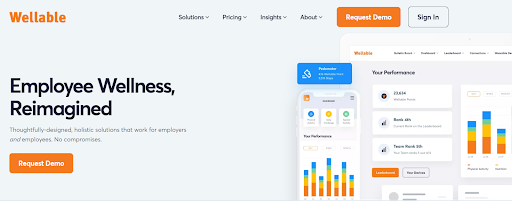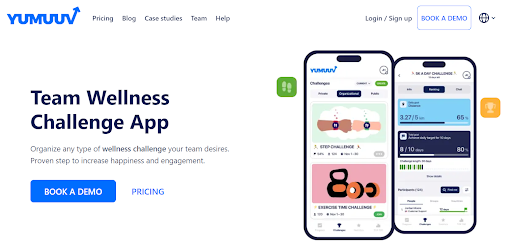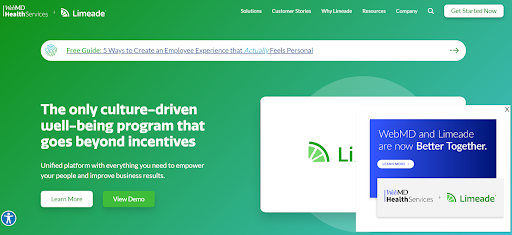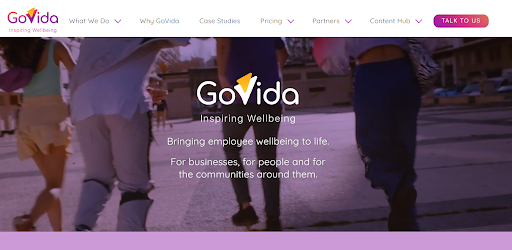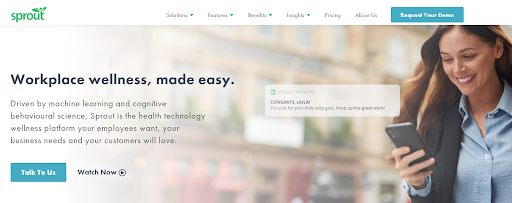Employee wellness platforms: A guide for HR professionals aiming to build a healthier workplace
Employee wellness is more important than ever.
Modern workers prioritize their well-being, and they need their company to do the same, or they look elsewhere.
You also need healthy employees to maintain productivity and reduce absenteeism, but nearly 60% of employees experience at least moderate levels of burnout.[1]
Managing a complicated wellness program is easier said than done with large workforces, but the solution can be simple: employee wellness software.
Employee wellness platforms are a convenient, centralized tool to manage employee wellness, encourage activity, and boost motivation. They also reduce the time spent on tedious tasks, increasing productivity.
This HR technology is a must-have to attract and retain the best talent.
This blog post discusses the benefits of corporate wellness programs and how to take advantage of them. It also includes a list of our top five software picks.
Table of contents
- What is an employee wellness platform?
- Why is corporate wellness software important to HR professionals?
- The benefits of employee well-being platforms
- 5 best corporate wellness softwares
- 5 best practices for leveraging employee health platforms in your HR department
- 3 examples of companies succeeding with employee wellness tools
- Promote a healthy, happy workforce with employee wellness software
- Employee wellness platform FAQs
What is an employee wellness platform?
An employee wellness platform is software that helps workers monitor and measure their health. It includes features to track physical health, such as sleep, nutrition, and activity. Many employee wellness platforms also track mental health, stress, and anxiety.
These platforms are powerful tools in your HR tech stack.
Taking the time to improve your employees’ health affects your bottom line, increases retention, reduces absenteeism, and makes you a more attractive employer.
Having a centralized platform to help you streamline the process and personalize wellness plans makes the process fit comfortably into your schedule.
Why is corporate wellness software important to HR professionals?
Corporate wellness software is becoming increasingly common for many reasons, but the main one is that the modern era strongly emphasizes wellness and health.
Employees and organizations realize the importance of activity, eating well, and encouraging healthy behaviors like smoking cessation.
Beyond this, employee well-being platforms also contribute to employee productivity and attendance. Healthy, happy workers are less likely to skip work and more likely to be efficient in their tasks.
These tools also reduce your healthcare costs, so corporate wellness software can greatly affect your bottom line.
You should also consider the state of employee well-being.
Employees reported that their physical and mental health worsened from 2022 to 2023. Nevertheless, most executives believe their health is improving, showing a critical gap in knowledge that needs to be bridged.
Narrowing this gap is difficult, if not impossible, to manage without wellness platforms. Growing businesses, which are already trying to juggle standard HR functions with a larger number of employees, find it even more daunting.
The same study shows managers are key to improving employee engagement through well-being but rarely get the right tools and support to do so.
Corporate wellness software also helps empower workers to take ownership of their wellness, featuring many employee self-service features.
Wellness tools are an essential HR technology trend that keeps your company ahead of the curve.
Similar to using AI in HR, employee health platforms give your HR team a competitive edge in managing a modern workforce.
The best insights on HR and recruitment, delivered to your inbox.
Biweekly updates. No spam. Unsubscribe any time.
The benefits of employee well-being platforms
Let’s examine the research and discover the benefits of using employee well-being tools in your organization.
Beyond the overarching HR tech trends, this software directly impacts crucial metrics in your people department, such as employee retention and engagement.
1. Improve employer branding
Job seekers are looking for more than just a competitive salary.
Your potential candidates want an organization with a positive view toward wellness and a comprehensive plan.
One study in Canada found that 77% of workers would leave their current position for a role that offered less compensation but better wellness support. Even those with high financial stress fell under this umbrella.
This demand is for more than just tangible employee benefits. Focusing on wellness shows candidates that your company is forward-thinking and puts people first.
For more insights, read our article on how employee wellness benefits talent acquisition.
2. Increase employee retention
Employee wellness software makes it simple to support your employees, improving their experience and retention rates.
Workers who strongly believe their employer cares about their well-being are 69% less likely to actively search for a new job.[2]
This impact is due to two main reasons:
Employees are satisfied with the company and don’t feel the need to search for new work
Employees are taken care of, not stressed and burnt out, which creates a sustainable environment for working
Employee well-being is imperative for a strong, happy workforce. It sets a strong foundation and sets you up for a long employee-employer relationship.
3. Boost employee engagement
Employees who believe their company cares about their well-being are three times more engaged on average.[2]
The knowledge that their employers care about them strongly connects workers to the company, improving loyalty and motivation.
Beyond that, these tools also improve mental and physical health by preventing and alleviating burnout, which is an enormous drain on engagement.
Using tech like wellness tools and employee recognition software is a good strategy to boost engagement, showing workers that their effort is appreciated and they aren’t just a “cog in the machine.”
4. Reduce costs
Employee health and wellness software uses health risk assessments to reduce risks and promotes preventative behaviors, positively affecting healthcare costs.
Medical costs can drop by about $3.27 for every dollar spent on well-being programs, and absenteeism costs can drop by about $2.73 for every dollar spent.[3]
It also reduces costs related to labor.
Like all HR automation, having tools to simplify and streamline tasks helps your team improve efficiency, reducing costs and enabling it to focus on more important responsibilities.
5 best corporate wellness softwares
The impact of corporate employee wellness platforms is clear, but countless tools exist on the market.
Let’s look at five of the best tools available to help you decide. We discuss the pros and cons of each choice, as well as pricing and ratings from a top review site.
Factors we considered
Here’s a quick overview of the factors we considered when choosing these tools:
Ease of use. Employee well-being tools must have a simple interface for managers and employees to encourage platform engagement.
Variety of health features. This tech must include a variety of features, such as activity tracking, sleep tracking, mental health support, and gamification.
Reporting analytics and data. Monitoring metrics and industry benchmarks helps you make informed decisions.
Third-party integrations. Employee wellness apps should integrate with other tools, such as email, calendar, and mobile devices.
The best corporate employee wellness platforms
Software | Top features |
1. Wellable | - All-in-one platform - Great engagement analytics - Excellent employee rewards |
2. YuMuuv | - A variety of team challenges - Gamifies wellness to engage employees - Accurate progress data |
3. Limeade | - Easily send employee wellness surveys - Detailed analytics - Communication channels for remote workers |
4. GoVida | - Simple interface - Large knowledge base - Team challenges and wellness communities |
5. Sprout | - Offers mental health features - Includes unique physical activities - Detailed analytics |
1. Wellable: Best overall
Wellable is one of the top employee wellness tools in the market.
This all-in-one platform offers deep customization, challenges, educational features, physical and mental health features, and incentives and rewards.
Wellable also provides HR analytics software features, enabling you to measure the effectiveness of your program through engagement metrics.
Pros | Cons |
- A wide variety of features - Simple interface - A great rewards system - Detailed engagement analytics | - Integrations occasionally disconnect - Some integrations require users to be tech-savvy |
Rating: 4.7 out of five (G2)
Pricing at time of writing: Starts at $75 per month
2. YuMuuv: Best for team collaboration
YuMuuv is an employee wellness solution that easily organizes team wellness events and challenges, even for global teams.
It features a variety of health challenges, including a step challenge, sleep challenge, planking challenge, and water drinking challenge. It gamifies well-being, an excellent way to engage workers.
YuMuuv also provides an easy way for employees and managers to view progress data.
The company claims that the average YuMuuv user is 54% more active than the average adult.
Pros | Cons |
- A large variety of health challenges to engage employees - Seamless integration with other software - Gamifies wellness - Great for team-building and collaboration | - No real-time syncing without logging in - Slow synchronization |
Rating: 4.4 out of five (G2)
Pricing at time of writing: $1,300 per year
3. Limeade: Best for building a culture of wellness
Limeade is an excellent way to encourage your organization’s overall culture of well-being.
This software helps you give your workforce a voice with easy access to employee pulse surveys, which improve staff engagement with well-being activities.
Further, it gives you actionable insights, enabling you to target core problems like burnout.
Limeade promotes inclusivity by enabling you to personalize your program to your unique workforce. It also offers a pre-made inclusion survey template.
Pros | Cons |
- Actionable data and insights - Easy access to surveys and recognition tools - Many third-party integrations with communication channels and well-being apps - Connections and multilingual options for remote and global teams | - White-labeling capability could be better - Not enough quality integrations |
Rating: 4.4 out of five (G2)
Pricing at time of writing: Available on request
4. GoVida: Best user experience
This platform has a simple, streamlined interface that makes it quick and easy to navigate and find the features you need, including an intuitive HR dashboard to help you build a strategic wellness strategy.
GoVida offers compelling gamification, with team challenges and a variety of rewards and recognition features.
On the more practical side, it gives employees a large knowledge base and social channels to spread healthy tips and advice.
Pros | Cons |
- An easy-to-use dashboard of real-time analytics - Simple rewards and incentives - Engaging community aspects - Very user-friendly and easy to use | - Needs more accurate and consistent step-tracking - Not enough quality integrations |
Rating: Five out of five (G2)
Pricing at time of writing: Available on request
5. Sprout: Best for mental and emotional health
Sprout is an employee well-being software that offers a robust solution to more than just physical activity.
This tool focuses on physical health, but it has a heavy emphasis on mental and emotional health. It promotes maintaining hobbies, volunteer and charity work, meditation, and deep breathing.
It also has inclusive features, such as counting housework as exercise, which is great for disabled employees and sedentary remote workers.
Reviewers say this makes everyone feel included, even if they aren’t the type to run a marathon.
Pros | Cons |
- Inclusive features - Focuses on mental, emotional, and spiritual health - Detailed data and analytics - Activity tracking and challenges alongside mental and emotional health features | - Inaccurate activity tracking - Poor customer support |
Rating: Five out of five (G2)
Pricing at time of writing: Available on request
5 best practices for leveraging employee health platforms in your HR department
Corporate wellness tracking software is a powerful tool to improve the well-being of your company, but we recommend looking at our tips before you get started.
Strategies for using corporate wellness software
Strategy | What it accomplishes |
1. Measure the impact of your wellness program and make adjustments as needed | Ensures your program is effective and has the expected return on investment |
2. Educate your employees on wellness and ensure they’re aware of the available resources | Encourages program engagement and builds a company culture of well-being |
3. Leverage gamification to increase engagement | Motivates and engages workers and builds stronger relationships |
4. Consider the wellness of your remote and distributed workforce | Supports the physical and mental health of staff who you can’t interact with physically |
5. Match employee skills to roles, improving well-being alongside your wellness platform | Builds a workforce that’s more confident in their work and less prone to burnout |
1. Measure the impact of your wellness program and make adjustments as needed
You must measure your wellness program’s metrics to determine its impact on your organization and maintain visibility into:
Employee engagement with the program
Total return on investment (ROI)
Wellness assessment and activity monitoring
The data and analytics in your employee wellness software are more than just an informative dashboard.
Wellness data insights let you take effective action, making small adjustments to your wellness initiatives until they’re perfect for your needs.
Wellness data also helps ensure your workforce gets the most out of its employee wellness apps. You can’t use benefits like talent attraction and retention unless employees have a positive, effective experience.
For more insights on how to improve this experience, read our piece on employee experience software.
2. Educate your employees on wellness and ensure they're aware of the available resources
The best way to increase engagement in employee wellness programs is to promote wellness in your company and encourage a culture of well-being.
Build wellness into your company’s core and adopt it as a value.
It’s much easier to encourage employees to participate in challenges, count steps, and take up healthy hobbies if the entire workplace supports well-being.
Encourage workers to use a mobile app, wearable devices, fitness trackers like Fitbit, and other wellness technology to overcome wellness challenges, promote healthy habits, and change the workplace culture.
Encourage this culture further by adopting employee wellness software like GoVida, which has a built-in learning management system for health coaching.
You can also use this focus to bring wellness resources front and center for your workforce. Tell your staff about your corporate wellness platform and all its features often, like through announcements on your group chat.
Engagement with wellness programs can sometimes suffer because employees aren’t aware of resources or aren’t adequately motivated to try them.
3. Leverage gamification to increase engagement
Gamification in HR brings game-like elements into usually tedious tasks by encouraging competition and introducing scores and leaderboards. It stirs employee interest in wellness and encourages them to engage with your program.
Here are some ways corporate wellness software can gamify well-being:
Earn points for activity
Earn points for drinking water
Employee leaderboards
Educational quizzes
Earn badges and prizes
Enabling staff to rack up points for taking walks and see their name move up a leaderboard engages them, helps build healthy working relationships, and encourages friendly competition.
4. Consider the wellness of your remote and distributed workforce
A distributed workforce carries many benefits, but you need to address the challenge of maintaining its health. It’s tricky to monitor remote employees’ physical health, and they’re prone to developing mental health issues like work-from-home depression.
You need to consider the health and well-being of remote employees. Managing your wellness program through an employee health platform makes it easier and more effective.
Wellness activities go beyond on-site activities. They can include webinars and modules about how to best create behavior change in remote employees to improve their well-being.
Hybrid work technology, like corporate wellness software, makes monitoring your entire workforce, even those not in the office, simple.
Moreover, many tools help remote teams, encouraging remote socialization, community channels, and a multilingual interface to assist global teams.
Tech like this enables you to maintain a healthy distributed workforce and build solid relationships, even with contingent workers. For example, you can use a vendor management system with your wellness tools to keep in touch with contractors and reduce burnout.
5. Match employee skills to roles, improving well-being alongside your wellness platform
You can get your workforce started on the right foot by hiring them with the best recruiting platforms.
Hiring people the right way has a direct tie to their overall well-being. Skills-based hiring methods like talent assessments enable you to gauge and match your candidate’s skills to your open role.
When a new hire has skills and competencies that align with a job position, it increases their confidence, satisfaction, and performance. This alignment leads to a better experience, enhancing employee well-being.
A workforce with the right skills is the perfect foundation for building your wellness strategy.
We recommend encouraging a skills-based mindset alongside your employee wellness software initiatives to subtly and gradually improve wellness alongside your other efforts.
For a deep dive into this subject, read our blog post on skills-based hiring and employee well-being.
3 examples of companies succeeding with employee wellness tools
Many organizations are taking advantage of the convenience and impact of employee wellness software.
Here are three real-life examples of companies leveraging these tools to help inspire your processes:
Ramirent
State of Washington
BDO
Ramirent
Ramirent, a subsidiary of Loxum Group, an equipment rental company, encourages a culture of health and wants to take its strategy to the next level.[4]
Its chief executive recognized the importance of supporting employees at work and in their personal lives. The company facilitated this strategy with corporate wellness software.
Ramirent wanted to encourage activity during dark and rainy seasons, promoting physical and mental health. Offering collaborative team challenges helped workers ward off seasonal affective disorder.
The organization addressed spiritual wellness by encouraging charitable work and supporting core company values.
The team agrees that these initiatives improved their collaboration and overall work culture. It’s now the norm to set wellness goals as a team.
State of Washington
When Governor Jay Inslee issued an executive order to improve state employees’ health, staff knew they needed solid corporate wellness software to tackle this challenge.
The State of Washington partnered with employee health platform Limeade to launch an online wellness program.
This program provided well-being goals and challenges to state workers, encouraging them to build personalized journeys.
Leadership buy-in was key, which resulted in the annual Governor’s Walk, where employees take part in a walk through the state capitol campus with the governor.
Even workers who weren’t on-site were encouraged to walk in their locations, and all participants received points in their employee wellness apps.
The results showed that this wellness program made the State of Washington a more attractive employer and reduced turnover.
This data also found that employees with high well-being have 25% less turnover than those with low well-being, a potential savings of $1.6m in turnover costs.
BDO
BDO, a global accounting firm, was scaling rapidly and wanted a simple way to encourage workplace wellness. It also needed robust remote working technology to aid its diverse, distributed workforce.
It built a holistic wellness program focused on physical and mental health, then executed it with corporate wellness software. It leveraged features that promoted meditation, mindfulness, emotional intelligence, and resilience.
BDO also engaged its remote workforce with regular team challenges to encourage connection and socialization.
It had great results:
User adoption: 86%
Average weekly engagement: 75%
Team challenge engagement: 94%
Daily steps activity increase: 21%
These initiatives started small in just one office, but owing to their overwhelming success, multiple offices now use the corporate employee wellness platform.[5]
Promote a healthy, happy workforce with employee wellness software
Corporate wellness software is essential for a modern company, enabling HR teams to promote healthy lifestyles without wasting their time and energy.
Taking advantage of employee health platforms enables you to:
Improve your talent acquisition and retention
Reduce costs
Boost engagement and reduce burnout
Healthy employees are a worthwhile investment.
The more you encourage physical and mental health, the more absentee rates drop and performance metrics rise.
For insights on monitoring this data, read our article on performance management systems.
Interested in how TestGorilla can improve your workforce’s well-being by matching skills to roles?
Watch a live demo or sign up for a free account today!
Employee wellness platform FAQs
Do employee wellness platforms work?
Yes, but you need dedicated effort and a well-targeted strategy. The main pitfall companies face with employee wellness tools is assuming the software does all the heavy lifting.
Determine your organization’s goals and choose a software that aligns with them. You can then build a program that addresses your specific needs.
How do you communicate a wellness program to employees?
Announce your wellness program through your usual communication channels, such as Slack or company intranet chat.
Most employee wellness software also has notification emails you can send to your workforce to inform and engage them.
Which employee wellness software features are in demand?
The top employee wellness software features include physical activity tracking, data and analytics, and health assessments.
Mental and emotional health are also increasingly important. Recent generations, such as millennials and Gen Z, are making these health elements more important than ever.
Who uses employee wellness platforms?
Employee wellness software is most commonly used by midsize to enterprise businesses. Small businesses also adopt it, especially if they have health-focused values or trouble managing employee health.
It’s essential to consider your company specifically. Even startups can use employee wellness platforms if they have a driving need.
Sources
"Workplace benefits trends". (2022). Aflac. Retrieved January 19, 2024. https://www.aflac.com/docs/awr/pdf/2022-trends-and-topics/2022-aflac-awr-employee-well-being-and-mental-health.pdf
"What Is Employee Wellbeing? And Why Does It Matter?". Gallup. Retrieved January 19, 2024. https://www.gallup.com/workplace/404105/importance-of-employee-well-being.aspx
Baicker, Katherine; Cutler, David; Song, Zirui. (February 2010). "Workplace Wellness Programs Can Generate Savings". HealthAffairs. Retrieved January 19, 2024. https://www.healthaffairs.org/doi/10.1377/hlthaff.2009.0626
Remmel, Jakob. “Unlocking Activity: Ramirent’s Successful Employee Activation”. Yumuuv. Retrieved January 23, 2024. https://yumuuv.com/ramirent-case-study
“Govida for global accountancy firm”. Govida. Retrieved January 23, 2024. https://govida.io/case-studies/govida-for-global-accountancy-firm/
You've scrolled this far
Why not try TestGorilla for free, and see what happens when you put skills first.


